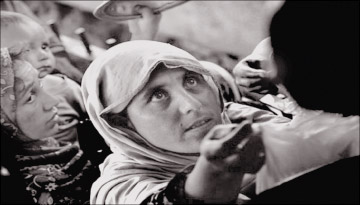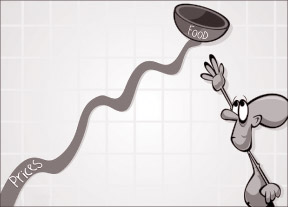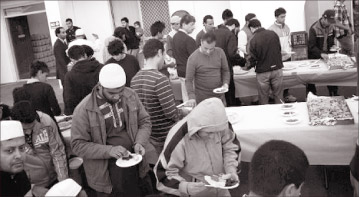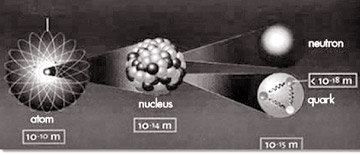ISLAM
Compiled by Latheef Farook E mail [email protected]
Solution in Islam to rising food prices
The Muslim world will be adversely impacted by rising food prices and
this will leave millions of Muslims deprived of food and vulnerable to
the harsh economic conditions imposed by the West.

The only way for the Muslim ummah to protect her from ever increasing
food prices is to work for the re-establishment of the Caliphate. The
Caliphate will protect its currency by basing it on the bimetallic
standard. Hence food prices will stabilize and will not undergo extreme
fluctuations as witnessed today.
Moreover, the Caliphate will prohibit food speculation, hoarding and
price fixing, thereby ensuring that all citizens of the state are able
to afford food. For those unfortunate citizens, who are unable to fend
for themselves, the Caliphate will buy foodstuffs from the open market
and tend to their needs.
|

A woman waits for free rice |
In November last year the UN warned that food prices could rise by 10
percent to 20 percent this year after poor harvests and an expected
rundown of global reserves. More than 70 African and Asian countries
will be the worst hit, said the Food and Agricultural Organization in
its monthly report.
In its gloomiest forecast since the 2007/08 food crisis, which saw
food riots in more than 25 countries and 100 million extra hungry
people, the report’s authors urged states to prepare for hardship.
“Countries must remain vigilant against supply shocks,” the report
warned. “Consumers may have little choice but to pay higher prices for
their food.
The size of this year’s harvest becomes increasingly critical. For
stocks to be replenished and prices to return to more normal levels,
large production expansions are needed.” Furthermore the UN warned that
international food import bills could pass the $1 trillion mark, with
prices in most commodities up sharply from 2009. Global food reserves,
which currently stand at around 74 days, are now expected to decrease
significantly in the next few months.

“Cereal reserves may drop by around seven percent, barley nearly 35
percent, maize 12 percent and wheat 10 percent. Only rice reserves are
expected to increase, by six percent next year,” said the report. Much
now hangs on this year’s harvests, it said. “International prices could
rise even more if production this year does not increase significantly –
especially in maize, soybean and wheat. Even the price of rice, the
supply of which is more adequate than other cereals, may be affected if
prices of other major food crops continue climbing.”
Whilst it is apparent that some of the food price hikes are due to a
fall in production-Russia’s ban on wheat exports in the aftermath of the
fires- the UN has again overlooked the main culprit, food speculation
and the declining value of the dollar. Both are playing havoc with food
prices worldwide.
The debasement of the dollar reduces the purchasing power of the
currency to buy goods and services. As most of the world’s staple foods
are traded in dollars, the country purchasing staple foods has to pay
more in order to secure the same amount of food supplies to feeds its
hungry population.
Often poorer countries do not have extra dollars to meet the rise in
food prices. Hence some nations are forced to borrow dollars at high
interest rates, which in turn makes them further indebted to the donor
nations. Other countries are forced to make structural changes to their
agricultural policies and grow cash crops instead of staple foods. Thus
poorer countries find themselves engulfed in a vicious cycle i.e. they
borrow more to pay off debtor nations and at the same time deprive their
people of food.
Still there are some poorer countries, which have abundance of staple
foods, but are forced to sell their crops to earn foreign exchange to
pay off debt owed to first world nations.
What makes the food equation even worse between the ‘haves and the
have nots’ is rampant speculation by the haves. Speculation usually
translates into huge food price spikes, especially when the value of the
dollar plunges. This is exactly what happened a few years ago. And now
after the recent announcement by the US Federal Reserve to spend an
extra $600 billion to stimulate the US economy, speculation on the price
of essential food commodities has increased and will continue do so for
a considerable time to come. The net effect is that food prices will
increase sharply and thereby deprive millions around the world of a
basic right.
The Muslim world will be adversely impacted by rising food prices and
this will leave millions of Muslims deprived of food and vulnerable to
the harsh economic conditions imposed by the West. The only way for the
Muslim world to protect from ever increasing food prices is to work for
the re-establishment of the Caliphate. The Caliphate will protect its
currency by basing it on the bimetallic standard. Hence food prices will
stabilize and will not undergo extreme fluctuations as witnessed today.
Moreover, the Caliphate will prohibit food speculation, hoarding and
price fixing, thereby ensuring that all citizens of the state are able
to afford food. For those unfortunate citizens, who are unable to fend
for themselves, the Caliphate will buy foodstuffs from the open market
and tend to their needs.
The messenger of Allah (SWT) said, “The Son of Adam has no better
right than that he would have a house wherein he may live, a piece of
clothing whereby he may hide his nakedness and a piece of bread and some
water.” [Tirmidhi)
Courtesy Hizb Ut Tahrir-UK.
Building bridges of understanding
Dr Mohamad Abdalla
Muslims have had a lengthy history in Australia, and their historic
narrative can be explored from three angles that roughly correspond with
the three stages of contact Muslims have had with both Indigenous
peoples and the broader Australian community.
|

An Iftar -breakfast- party held during Ramadhan fasting last
year |
The earliest stage was prior to British colonisation and mainly
consisted of social, cultural and economic contacts between indigenous
Australians and Macassan fishermen in areas of the Northern Territory
and northern Western Australia. The second stage was as a result of
British colonialism and during this period a number of Muslims of
various ethnic backgrounds entered Australia.
The earliest contacts with Muslims in Australia were between the
indigenous peoples of Northern Australia and fishermen from Makassar
(formerly Ujung Pandang), southern Sulawesi in Indonesia. The Macassans
came to Australian waters near Arnhem Land and the Kimberley coast in
search of trepang, a type of sea cucumber for use as an aphrodisiac,
which the Macassans exported to Chinese markets. This contact lasted for
centuries, with some records in Sulawesi history showing that fishermen
had visited northern Australia regularly since the 1600s. As a result,
this regular contact had a deep impact on both the culture and language
of indigenous people.
Between the 1860s and 1920s, approximately 2000 Afghan cameleers
arrived in Australia. These cameleers and European entrepreneurs
imported more than 20 000 camels to Australia, where their ability to
transport heavy loads over long distances came into use. The efficiency
of the camel saddles allowed the camels to carry more than 600 kilograms
of equipment over hundreds of kilometres. These cameleers pioneered a
network of trails and tracks that later became today’s roads, linking
towns, stations, mines and missions all across the Australian outback.
Australian Muslims are not a monolithic entity. Like other minority
groups, they are characterized by religious, ethnic, cultural and
socioeconomic diversity. Muslims who have migrated to Australia come
from a wide variety of cultural backgrounds including Lebanon, Turkey,
Bosnia, Pakistan, Indonesia, Iraq, and Bangladesh, with many more
Muslims from other national and ethnic backgrounds. In fact, about 35
percent of Australian Muslims were born in Australia, and the rest
migrated to Australia from over seventy different countries. Currently,
there are more than 100 mosques and over 25 Muslim schools in Australia.
Of course, since Muslim people have been in Australia for some time
now, there are up to third-generation Muslims living here today. In some
cases, families have been here even longer than three generations.
According to the 2006 census, Muslims constitute 1.7 percent, or
approximately 340 394 people, in Australia. Compared to the 2001 census
(281 578 Muslims) and 1996 census (200 885 Muslims), this figure
represents a considerable increase. However, the rate of increase over
the five-year inter- census period has actually dropped from 40 percent
in the 1996–2001 interval to only 21 percent in the 2001–06 period.
Interestingly, about 60 percent of Muslims were born overseas, about 91
000 are considered second generation, with almost 7500 as third-
generation Australian Muslims. As a result, around half of the Muslim
population is under the age of twenty-five, and most Australian Muslims
are under the age of twenty-one and were born in Australia.
Despite a rich history of Muslim immigration into Australia, there is
little research on their role as active Australian citizens. This
changed somewhat post–September 2001, when ‘interest in Muslims as
citizens in the west has attracted increasing attention against the
backdrop of additional terrorist attacks in Bali (2002), Madrid (2004),
and London (2005). The ‘war on terror’ and the emerging political and
media discourse of fear and citizenship encouraged Australian Muslims to
become more active than had been the case in the 1990s. This activism
manifested itself at the national level in Muslim organizations
broadening their agenda. Instead of confining themselves to internal
community needs, these organizations began to emphasize the need for
building bridges of understanding and political activism and advocacy.
In times of tension, the Muslim community’s calm and compelling
demeanor has successfully contained and managed reconciliation
strategies between the Islamic and Australian communities. For example,
after September 11 2001, the Kuraby mosque in Brisbane was burned to the
ground.
The Kuraby Muslim community called for and attained restraint towards
and forgiveness for the perpetrator. They led a reconciliation strategy
to create better understanding between the local Islamic and wider
Australian community.
The mosque opened its doors for the wider Australian community to
visit and observe how Muslims worship, and engaged in a discussion about
Islam. Many Christian groups and churches responded positively, and
interfaith gatherings are ongoing.
Mohamad Abdalla is an Associate Professor and Director of the
Griffith Islamic Research Unit (GIRU) at Griffith University, Brisbane,
Australia
Atomic energy and fission
Allah splits the seed and kernel. He brings forth the living from the
dead, and produces the dead out of the living. That is Allah, so how are
you misguided? (Qur'an, 6:95)
|

Today, atomic nucleus can be split into smaller nuclei by
means of nuclear fission. |
The terms “seed” (al-habb) and “kernel” (an-nawa) in the above verse
may indicate the splitting of the atom. Indeed, the dictionary meanings
of an-nawa include “nucleus, centre, atomic nucleus.” Furthermore, the
description of bringing forth the living from the dead can be
interpreted as Allah creating matter from dead energy.
Producing the dead out of the living may refer to energy (dead)
emerging from matter (living), since the atom is in motion. (Allah knows
best.)
That is because as well as “living,” al-hayy can also mean “active,
energetic.” With its meaning of “non-living,” al-mayyit, translated
above as “dead,” may very probably refer to energy.
Scientists define energy as the capacity for doing work. Matter, the
material that comprises all things on Earth and in the universe,
consists of atoms and molecules that can be seen to be in motion under
an electron microscope. In the early twentieth century, Albert Einstein
(d. 1955) theorised that matter could be converted into energy,
suggesting that the two were inter-related at the atomic level.199
This may be the bringing forth of the dead from the living, as
described above, or, in other words, obtaining energy from matter, which
is in motion at the atomic level.
In addition, yukhriju, translated as “bringing forth,” also means
“bringing out, emitting” (as in the case of electrical waves).
Therefore, the terms in this verse may be indicating the form of energy
obtained from the atom. (Allah knows best.)
Scientists can now split the atom by dividing its nucleus. Taking
Einstein's theories as their starting point, they obtained energy from
matter in the 1940s by means of nuclear fission, the process of
splitting the atomic nucleus. The verb faliqu in Surat al-An'am 95,
translated as “to split,” may be a reference to fission's dictionary
meaning: the process of splitting (the atom's nucleus). When this
process takes place, enormous amounts of energy are released.
The words in Surat al-An'am 95 are very wise in terms of their
meanings. The phenomena described in this verse bear a very close
resemblance to the splitting of the atom's nucleus in order to obtain
atomic energy.
The verse may therefore be a reference to nuclear fission, which was
only made possible by twentieth-century technology. (Allah knows best.)
Scientific miracles of the Qur'an
Programming in genes :
From what thing did He create him? From a drop of sperm He created
him and proportioned him. Then He eases the way for him. (Qur'an,
80:18-20)
The word “qaddarahu,” translated as “proportioned” in the above
verse, comes from the Arabic verb “qadare.” It translates as “arranging,
setting out, planning, programming, seeing the future, the writing of
everything in destiny (by Allah).”
When the father's sperm cell fertilises the mother's egg, the
parents’ genes combine to determine all of the baby's physical
characteristics. Each one of these thousands of genes has a specific
function. It is the genes which determine the colour of the eyes and
hair, height, facial features, skeletal shape and the countless details
in the internal organs, brain, nerves and muscles. In addition to all
the physical characteristics, thousands of different processes taking
place in the cells and body-and indeed the control of the whole
system-are recorded in the genes.
For example, whether a person's blood pressure is generally high, low
or normal depends on the information in his or her genes.
The first cell which forms when the sperm and the egg are joined also
forms the first copy of the DNA molecule which will carry the code in
every cell of the person's body, right up until death. DNA is a molecule
of considerable size. It is carefully protected within the nucleus of
the cell and this molecule is an information bank of the human body as
it contains the genes we mentioned above.
The first cell, the fertilised egg, then divides and multiplies in
the light of the program recorded in the DNA. The tissues and organs
begin to form: This is the beginning of a human being. The coordination
of this complex structuring is brought about by the DNA molecule. This
is a molecule consisting of atoms such as carbon, phosphorus, nitrogen,
hydrogen and oxygen.
The information capacity recorded in DNA is of a size which
astonishes scientists. There is enough information in a single human DNA
molecule to fill a million encyclopedia pages or 1,000 volumes. To put
it another way, the nucleus of a cell contains information, equivalent
to that in a 1 million-page encyclopedia. It serves to control all the
functions of the human body. To make a comparison, the 23-volume
Encyclopedia Britannica, one of the largest encyclopedias in the world,
contains a total of 25,000 pages. Yet a single molecule in the nucleus
of a cell, and which is so much smaller than that cell, contains a store
of information 40 times larger than the world's largest encyclopedias.
That means that what we have here is a 1,000-volume encyclopedia, the
like of which exists nowhere else on Earth. This is a miracle of design
and creation within our very own bodies, for which evolutionists and
materialists have no answer.
Bearing in mind that the structure of DNA was unraveled by Francis
Crick in 1953, it is truly amazing that the Qur'an pointed to the
concept of “genetic planning” in an age when, as we have mentioned
previously, mankind's knowledge was very limited. Geneticists were
unable to discuss until the end of the 19th century and these remarkable
facts act again as proofs that the Qur'an is the Word of Allah. |



